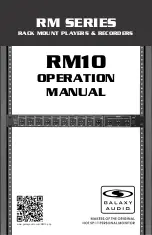
14
To make VTA adjustment easier, you can rotate the ring while holding the main knob to
adjust the zero starting point on the knob. This knob can rotate a little even when the lever is
in the lock position (the lever locks the support mechanism and not the knob itself). The
lever, gently pushed into the lock position, gives rigidity to the VTA system due to its special
construction. Fine adjustments, of only few 0.1mm, will make a big difference in sound on the
same LP. Bear in mind that the tonearm cables need at least 40 hours of 'burning in' for
optimal performance.
5.7. Adjustment of azimuth:
To make azimuth adjustments, release the two screws locking the mechanism at the centre top
of the tube, with Allen key 2mm. The small tube, with a hexagonal screw on the left side, is
for fine rotation of the tube. To change azimuth, insert Allen key 2mm and finely rotate it.
The Allen key might feel loose in the screw but when you rotate it, by small increments, it
will change the azimuth. Returning it back will bring azimuth to its previous position.
Changes can be seen by misalignment of the white lines on the top of the centre of the tube.
Even 15 degrees rotation of the Allen key will make a significant difference.
Of course the use of a test record and oscilloscope is mandatory for optimal azimuth. VTA
changes and even changes in the height of the armbase will not change azimuth, due to
precision in construction.
5.8. Adjustment of the cueing device:
The cueing device has no damping for motion as is usual. Due to the construction it is not
needed. It can stay in any position and can be precisely cued on the record. Using the Allen
key 1.5mm to release the small knob, which holds the lever and rotating it, we can adjust the
height of the cartridge above the record.
Note: Cueing device level resistance:
The blocking plate, at the end of air bearing shaft, controls ease of movement of cueing
device lever. If released with Allen key 4mm, it can be pushed away from the main tone arm
tower and this eases movement. When fixing the blocking plate back, be sure that it is parallel
to the main tower, otherwise this can cause the distance from diamond tip to record surface to
be different at the outer grooves compared to the inner grooves. Slight rotation of the blocking
plate can correct this. See page 16.
6.0. Operation of the tonearm:
The compressor should be permanently switched ON. When tonearm is not in use, the valve
on the tonearm should be in the lock (closed) position. In use, open the valve and move the
tonearm once or twice along the main bearing shaft (if tonearm has not been used for more
then few days). This will clean the shaft of dust particles.
After use merely close the valve on the tonearm and the pressure indicator on the tonearm will
show zero pressure. You cannot move tonearm now. The compressor will go on stand by.
Every few hours or so air release noises can be heard and the compressor will switch on a few
times per day when resting in the stand by position. Cue cartridge slowly.




































